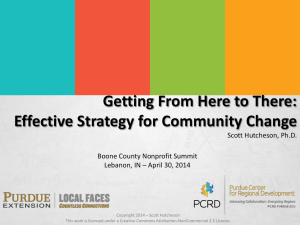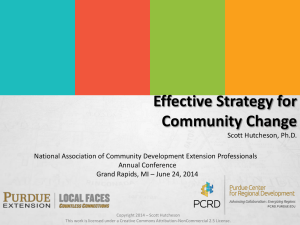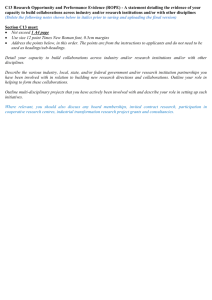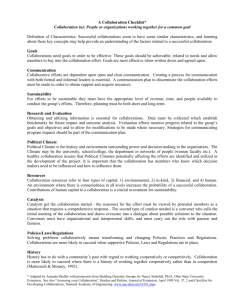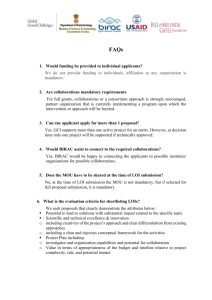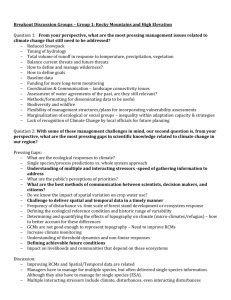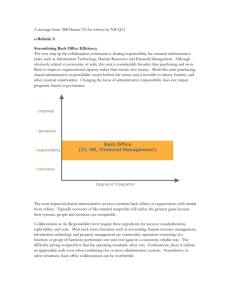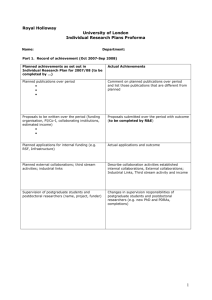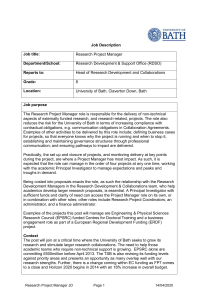File - Purdue Center for Regional Development
advertisement
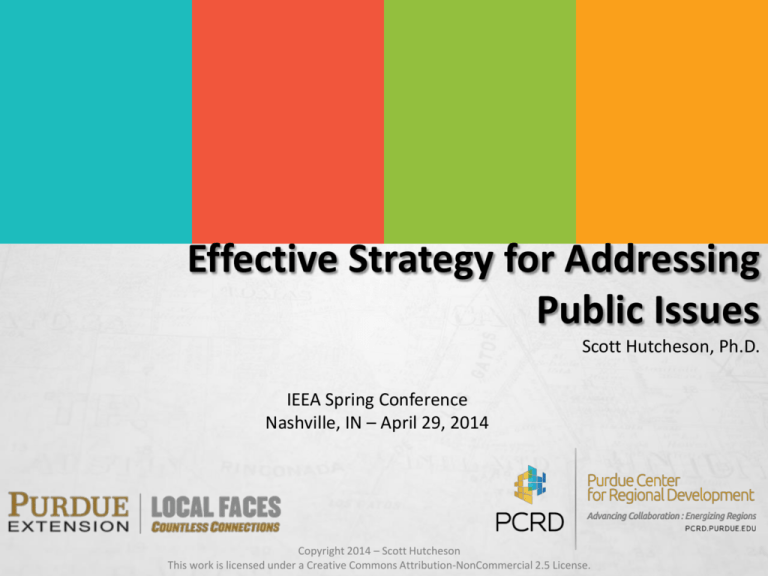
Effective Strategy for Addressing Public Issues Scott Hutcheson, Ph.D. IEEA Spring Conference Nashville, IN – April 29, 2014 Copyright 2014 – Scott Hutcheson This work is licensed under a Creative Commons Attribution-NonCommercial 2.5 License. • Present insights from research on the effective development and implementation of strategies to address community-based public issues • Explore how to incorporate findings into Extension community-based public issues work What to Expect From This Session The Great and the Near Great in the White River Country by Z. M. Horton The Baxter Bulletin Better understand he nature of collaboration Identify what stage your collaborations are in Consider ways to move a collaborations to the next level Dec 31, 1915 S. J. Hutcheson, a well known farmer and stockman of Norfork, roping a calf White River Ferry at Norfork, Arkansas, circa 1900 Norfork, Arkansas (pop. 550) Better understand he nature of collaboration Identify what stage your collaborations are in Consider ways to move a collaborations to the next level Our communities, big and small, are dealing with complex PUBLIC ISSUES ✔ ✔ ✔ ✔ Our communities, big and small, are dealing with complex PUBLIC ISSUES Research Question Why are some strategies for addressing public Better understand he nature of collaboration Identify what stage your collaborations are in successful Considerissues ways to move a collaborations toand the next level others…not so much? 1. Literature review 2. Interviews 3. Surveys A grounded theory exploration using a sequential mixed method approach beginning with a qualitative phase in which semistructured interviews resulting were conducted with a purposively sampled panel of experts resulting in data that was open coded using the data spiral analysis method followed by a quasi-experimental quantitative phase in which two contrasted groups of purposefully sampled, randomly assigned participants were surveyed, resulting in data that was analyzed using Spearman’s rho to determine correlation coefficients. Answering the Question Problem Statement • Literature gap regarding factors contributing to effective strategy in the context of public issues like economic development (Kwon, Berry, & Feiock, 2009). Better understand he nature of collaboration • Civic leaders face daunting tasks of Identify what stage your collaborations are in developing and implementing Consider ways to move a collaborations to the next level strategies to address these public issues (Markey, 2010). • Very little research-based information to guide decisions about effective strategy-development processes. • Evolution of public issues • Institutionalization • Locus of control • Increasing complexity • Tools for managing public issues • Early tools • Evolving tools • Emerging tools • Contributing theories • Strategy formation • Collaborative governance • Social innovation Conducted as part of the grounded theory data collection process (McGhee, Marland, and Atkinson, 2007). Conducted to provide contextualization (Dunne, 2011) and orientation to the phenomenon (Pozzebon, Petrini, de Mellow, and Garreau, 2011). Insights from the Literature Institutionalization Evolution of How We Deal with Public Issues • Pre-institutional (Pre- WW2) • Institutional (1950-1990) • Multi-Institutional (1990 to today) Better understand he nature of collaboration Locus of Control Identify what stage your collaborations are in • Control theahands of the to “elite” (Perrucci Consider ways to in move collaborations the next level & Pilisuk, 1970). • Most economic & community development issues are “Type 3 Public Problems” and control is shared by a group of “nonexperts” (Heifitz and Sinder, 1988). Complexity Boulding, K. (1956). General systems theory—the skeleton of science. Management Science 2(3): 197-208. •Social Organizations – economics, education, politics •Individual Human – language capacity, knowledge accumulation, design and use of tools •Animal – mobility, information processing •Plants – viability •Open Systems – matter, energy •Cybernetics – computers •Clockworks – engines •Frameworks – buildings, cells Hierarchy of Complex Systems 14 The Extension Economist Vs. The Rocket Scientist 15 Complexity Boulding, K. (1956). General systems theory—the skeleton of science. Management Science 2(3): 197-208. • Social Organizations – economics, education, politics • Individual Human – language capacity, knowledge accumulation, design and use of tools • Animal – mobility, information processing • Plants – viability • Open Systems – matter, energy • Cybernetics – computers • Clockworks – engines • Frameworks – buildings, cells Hierarchy of Complex Systems 16 Complexity Boulding, K. (1956). General systems theory—the skeleton of science. Management Science 2(3): 197-208. • Social Organizations – economics, education, politics • Individual Human – language capacity, knowledge accumulation, design and use of tools • Animal – mobility, information processing • Plants – viability • Open Systems – matter, energy • Cybernetics – computers • Clockworks – engines • Frameworks – buildings, cells Hierarchy of Complex Systems 17 Complexity Boulding, K. (1956). General systems theory—the skeleton of science. Management Science 2(3): 197-208. • Social Organizations – economics, education, politics • Individual Human – language capacity, knowledge accumulation, design and use of tools • Animal – mobility, information processing • Plants – viability • Open Systems – matter, energy • Cybernetics – computers • Clockworks – engines • Frameworks – buildings, cells Hierarchy of Complex Systems 18 Dealing with the Complexity Early Models • 1960s in universities, schools, municipalities (Hamilton, 2007) • Late 1980s/Early 1990s first economic development strategic plans (Blackerby & Blackerby, 1995) • Borrowed from industry models (Blair,2004) Evolving Models • Recognition that corporate models are less effective (Bryson and Roering, 1987). • U.S. Economic Development Administration’s CEDS; Cooperative Extension Service’s Take Charge (Hein, Cole, & Ayres, 1990); Asset-Based Community Development, (Kretzmann and McKnight, 1996; Community Capitals, Flora, 1992) Emerging Models • Effectiveness of strategic planning in business questioned (Mintzberg, 1994). • Effectiveness of strategic planning in economic & community development questioned ( Blair, 2004; Robichau, 2010; Morrison, 2012) • Organic Strategic Planning (McNamara, 2010, Open Source Economic 19 Development (Merkel, 2010), Strategic Doing (Hutcheson, 2008; Public issues are complex Complexity = Messes Complex environment understand he Institutions emerged to deal with the complexity Better nature of collaboration Identify what stage your collaborations are in Consider ways to move a collaborations to the next level No single institution is “in charge” of most public issues There are lots of institutions Contributing Theories • Social Innovation • Strategy Formation • Collaborative Governance 21 Social innovations… • are best designed and implemented in networks • emerge from heterogeneousness (diversity) • are framed using existing assets • are products of co-creation • are the result of collective action • should have decentralized implementation • ,when implemented should focus on tangible results Bland, Bruk, Kim, and Lee (2010); Bouchard (2012); Mulgan, Ali, Tucker and Sanders (2007); Neumeier (2012); Oliveira and Breda-Vazquez (2012) Social Innovation Strategies… • are formed intuitively • are iterative • must be designed to account for unanticipated variables • must take into account contextual values, assumptions, beliefs, and expectations • must be flexible • should be designed collaboratively • and best developed as an intra-organizational activity Feser, 2012; Johanson, 2009; Lindblom, 1959; Mintzberg, 1978; Parnell, 2008; Rindova, Dalpiaz, and Ravasi, 2011; Sminia, 2012; Tapinos, Dyson, and Meadows, 2011 Strategy Formation Collaborative governance… • takes advantage of network structures • connects existing assets • focuses first on small wins • Requires decision making to be made by consensus • works when there is trust among participants • is efficient • involves successful management of both internal and external stakeholders Ansell and Gash, 2008; Chiclana et al., 2013; Clarke, Huxley, Mountford, 2010; Emerson, Nabatchi, and Balogh, 2012; Gibson, 2011; Johnston, Hicks, Nan, and Auer, 2011; Kwon, Berry, and Feiock, 2009; Merkle , 2010; Olberding, 2009; Ospina and Saz-Carranza, 2010; Pammer, 1998; Poister, 2010 Collaborative Governance These Things Matter • Organizational Structure (hierarchy, network, etc.) • Framework (asset-based, deficitbased) • Processes (planning and Implementation and distinct, Better understand he natureseparate of collaboration planning and Identify what stage yourimplementation collaborations are in integrated Consider to move aetc.) collaborations to the next level andways iterative, • Timeframe (focused on longer-term goals, focused on shorter-term goals, etc.) • Implementation (tasks centralized with one organization, tasked disseminated among multiple organizations) The Qualitative Data • Population of scholars and practitioners who design curricula, teach, and/or practice strategy development for addressing public issues (economic development, community development, community health, etc.) • Sample: N=12 • Semi-structured interviews (IRB-approved, anonymity) • Verbatim transcripts, data spiral analysis with three levels of coding: open, axial, selective using qualitative analysis software • 56 single-spaced pages/over 31,000 words of data Insights from the Panel of Experts Findings from the Interviews 1. 2. 3. 4. 5. 6. 7. 8. Network organization structures Asset-based Frameworks Iterative planning/implementation process Inclusion of shorter-term goals Decentralized implementation Metrics to learn what is working High levels of trust among participants Readiness for change in community 27 Variables 1. 2. 3. 4. 5. 6. 7. 8. Network organization structures Asset-based Frameworks Iterative planning/implementation process Inclusion of shorter-term goals Decentralized implementation Metrics to learn what is working High levels of trust among participants Readiness for change in community Dependent Variable = Effectiveness Independent Variables 28 Effectiveness For the effective strategy initiative you have in mind, how would you describe its level of effectiveness: • Completely effective • Significantly effective • Somewhat effective Measuring the Variables Ineffectiveness For the ineffective strategy initiative you have in mind, how would you describe its level of ineffectiveness: • Somewhat ineffective • Significantly ineffective • Completely ineffective Organizational Structure, etc. Hierarchical, with a clear top and bottom Network, with a hub and spokes The Quantitative Data • Population of individuals who have participated in community-based strategy initiatives to address public issues (economic development, community development, community health, etc.) • Sample of 300 (plus those reached by use of snowball sample) participants were randomly selected from PCRD contact database (N=209). Assured that Indiana was not over represented • IRB-approved survey constructed using the factors identified in phase 1, participants randomly assigned to two contrasting groups Insights from Participants Findings from the Surveys Effective & Ineffective Strategy Initiatives – Mean Responses 31 Source: Scott Hutcheson, Distributed under a Creative Commons 3.0 License. Dependent Variables Correlation Effectiveness Continuum Completely Effective Significantly Effective Somewhat Effective Significantly Ineffective Somewhat Ineffective Findings from the Survey Completely Ineffective Findings from the Surveys Correlation Between Strategy Initiative Effectiveness and the Eight Independent Variables 33 Source: Scott Hutcheson, Distributed under a Creative Commons 3.0 License. • Have a network organizational structure • Frame strategies primarily around building on existing assets • Have a planning and implementation processes that is iterative • Include short-term, easy-win goals • Decentralize responsibilities for implementation among multiple organization • Use metrics to learn what is working and to make adjustments along the way • Build high levels of trust among participants • Assure that participants are ready to change Recipe for EFFECTIVE Strategies Recipe for INEFFECTIVE Strategies • Have a hierarchical organizational structure • Frame strategies primarily around addressing problems or deficits • Have a planning and implementation process that is linear and sequential • Include only long-term, transformational goals • Centralized responsibilities for implementation with one organization • Uses metrics primarily for accountability • Proceed even though there are low levels of trust among participants • Proceed although participants are not ready for change Improving Our Practice Addressing Public Issues • Think about public issues differently • Accelerate the collaborations needed to address them • Develop and implement agile, asset-based strategies to meet a progressive series of clearly defined strategic objectives Framing Community Conversations Exercise One: Reframing Public Issues Choose one of the following problem-centered statements about public issues and reframe it as an opportunity-centered question. 1. Somebody needs to do something about the graffiti on our downtown buildings 2. We can’t keep our smartest kids here. We’re suffering from “brain drain.” 3. In the good old days we had great manufacturing jobs that paid a great wage. 4. People are not eating enough fruits and vegetables. 5. Our kids are not getting the math and science skills they need. 39 The Collaboration Continuum Trust Co-Creation Co-Execution Turf Sharing Resources Sharing Information Mutual Awareness Acknowledgment Exploration Cooperation Collaboration Innovation TIME Adapted from Collaboration Continuum from ACT for Youth Exercise Two: Accelerating Collaboration 1. Consider a collaboration that is important to your work 2. Ask yourself what stage on the continuum is that collaboration in now? 3. Think of specific steps you could take to move the collaboration to the next level Thank You Scott Hutcheson, Ph.D. 765-479-7704 hutcheson@purdue.edu www.linkedin.com/in/scotthutcheson/ www.twitter.com/jshutch64 www.facebook.com/scott.hutcheson Copyright 2014 – Scott Hutcheson This work is licensed under a Creative Commons Attribution-NonCommercial 2.5 License.
